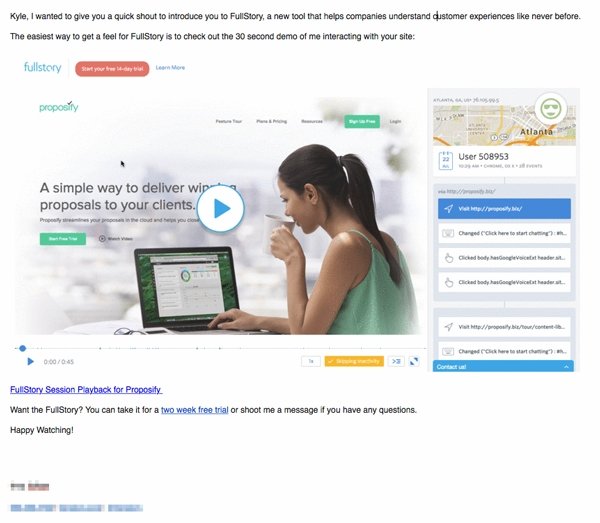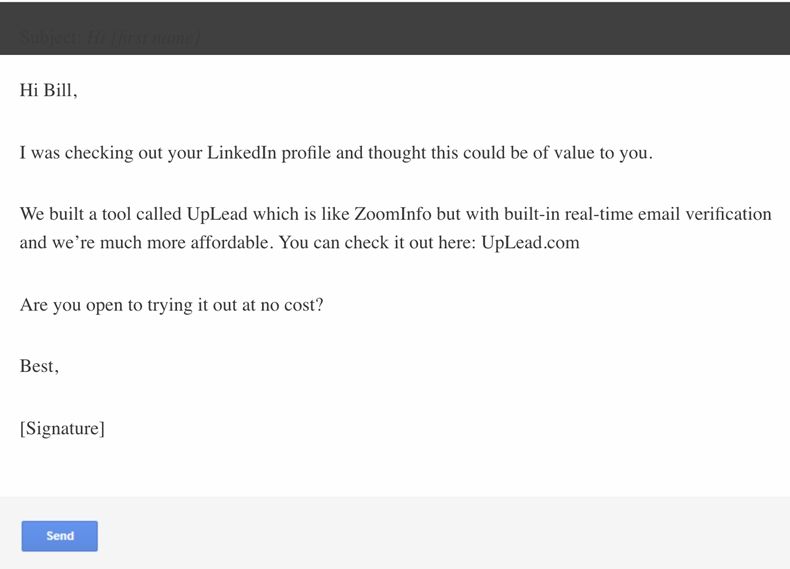The doom and gloom of GDPR aside, cold email is still an effective way of generating appointments and making new connections. Of course, we can't pretend GDPR doesn't exist. But as a B2B company, you can still send personalized, cold emails at scale.
In this article, I'll share several cold email principles that you can use to create response-boosting outreach campaigns.
Step 0: Understand customer pain points
Before we get into the nitty-gritty, there's a foundational step that must be covered: understanding the current, relevant pain points of your ideal customer, which will help you cut through the noise in your recipients inbox.
By using segment-specific email copy, you're going to have a much easier time getting your prospect's attention and compelling them to open your email.
Here are some data-driven approaches, as laid out by Chris Blohm of MeritDirect:
- Firmographic data: Basic information, such as industry, employee count, and investment funding
- Intent: Determined by looking at the content each segment consumes and analyzing patterns in the challenges they cover
- Analytics: For figuring out how each customer segment interacts with your marketing, and measuring the customer journey for key insights
There's also technographic data, which shows you which platforms and tools your target accounts use. Know that can fuel your cold email by mentioning how your solution compliments their current technology stack, or how you fare against a specific competitor they're already using.
Step 1: Create a relevant and catchy subject line
Now you have a key understanding of your customers, it's time to put pen to paper. The first thing your recipients will see of your email is the subject line, and its job is to get your email opened. To succeed, you need to stand out from clutter that can looks like this:

The number of emails that B2B professionals are bombarded with on a daily basis is rising. If you're going to cut through the noise, you need a subject line...
- That's relevant to their goals and challenges
- That piques their interest enough to open the email itself
Pique your prospect's interest, but also be clear on what your email is about. Don't force your prospect to figure out what's on the other side of the subject line.
Step 2: Get to the point
Once your prospect has opened your email, you need to hook them into learning more. It's important to avoid talking about yourself. If you start listing out your credentials and what your business does, it's likely your email is going into the trash.
Instead, focus on them.
Use the challenges the customer faces to fuel personalization at scale by segmenting your outreach lists. Create an element of personalization. Be as specific to the recipient as possible. Make it clear how you can solve their specific challenges and help them reach their goals.
And keep it brief. Brevity is a principle that should run through your entire cold email. Don't use unnecessary fluff talk. A good rule of thumb is to use no more than five sentences. Any more, and you may begin to see your response rate drop.
Step 3: Show credibility
Now you've put your prospects in the spotlight of your email. They know you understand them and their challenges. Now it's time to talk about you.
The best way? Show some authority by...
- Listing names of clients you work with
- Including publications you've been featured in
- Mentioning results you've gotten for your customers and clients
Think of how you can make your prospect trust you. It's OK to name-drop: It shows you have experience and credibility within your industry.
Another way to build credibility with your recipients is to warm them up before you begin reaching out.
Adam Grunwerg, partner at Investoo Group, puts it best: "Retweet [the influencers'] articles or compliment their work before tweeting them from your personal (not brand!) account. Provide a teaser for your content, and ask them permission to send them an email. They will appreciate the courtesy."
Do this by figuring out which communities, publications, and influencers they follow and interact with. Comment on their content and join the conversation on the forums they hang out in. All that will help you to become a recognizable name when you land in their inbox.
Step 4: Use a simple CTA
I don't know about you, but when I get a cold email that asks whether I'm free on a specific time and date, I usually respond "no" in my mind. That micro-objection is a major hurdle: The prospect will already have begun the journey to noncommitment.
Instead, when writing cold emails, you must build as many "micro-yes" scenarios as possible. The best place to do that is in your call to action.
Again, here's what most salespeople and B2B marketers do when reaching out to secure appointments: "Are you available for a 30-minute call next Tuesday at 10 AM to discuss this?"
It's too specific, and it's unlikely that the prospect will look in their calendar to check. Instead, use your email to gauge interest. For example, these calls to action will encourage a small commitment and begin a dialog:
- Is this something that would be of interest?
- Would you like to learn more?
- Do you feel we may be a good fit?
These "soft CTAs" do not assume anything. They're simply there to get the conversation started and take it to the next step: the appointment.
Step 5: Personalize
Let's dig deeper into personalization. Many salespeople find it an arduous task, as it requires writing different introductions or sentences for each email they're sending.
Personalization has moved from "including first name and company" to "customizing your message based on the goals and challenges of your prospect." With that in mind, how do you scale this approach?
The answer: create hyper-segments—groups of customers who share similar desires, or hurdles that they're trying to overcome. Instead of writing emails one at a time, simply tailor your message to each group. This approach will help you create a scalable process you can run again and again.
Of course, if you're a professional service or offer a high-ticket solution, personalizing each email can work wonders. In fact, that is exactly what FullStory did when it reached out to Proposify:

Instead of telling Proposify how the FullStory software could help, they showed Proposify what it would look like on its website. This approach got Proposify's attention enough to write about it.
Step 6: Add a P.S. and contact details
In the world of copywriting, there's a principle known as "double readership paths." This is where you create subheadings, bullet points, and bold text to grab the attention of people who prefer to scan content before committing.
In your cold emails, your P.S. is often the best way to get these skim-readers to pay attention to what you have to say.
In the P.S., you can summarize the contents of your email or even repeat your call to action with a relevant link to your landing page. It's also an opportunity to outline any secondary benefits that you didn't make room for in your main email copy.
So, what comes after the P.S.? Your contact details and signature. They offer another opportunity to reinforce your value proposition and provide links to your website. Not to mention that including your contact details is a legal requirement.
Here's how we generate a 24% response rate
Let's wrap things up by showing how we do cold email at UpLead. Below is the exact cold email we send to our prospects that generates a 78% open rate and 24% response rate:

Here's a breakdown:
- We open the email with how we found them, adding an element of personalization. It's also short and sweet, allowing us to get to the point.
- We drop in a relevant competitor and quickly touch on our strengths, along with a link that they can use to research our platform before committing to next steps.
- The call to action is super simple: We're offering them to try our solution for free. For many of our prospects, that's a no-brainer. We're reducing their risk in a way that incurs no cost on our part.
As you can see, there's nothing special about our script besides how simple it is and how easy we make it for prospects to say "yes" and hit the "reply" button.
* * *
Give it a go. Test these six principles and measure how they affect your response rates.




